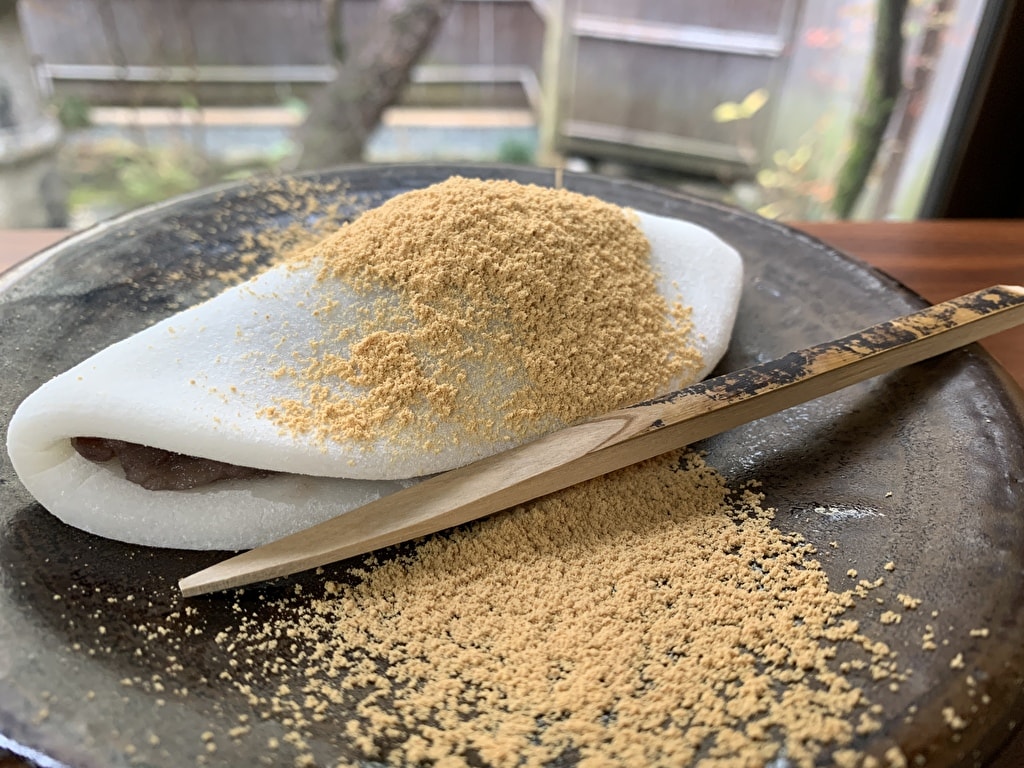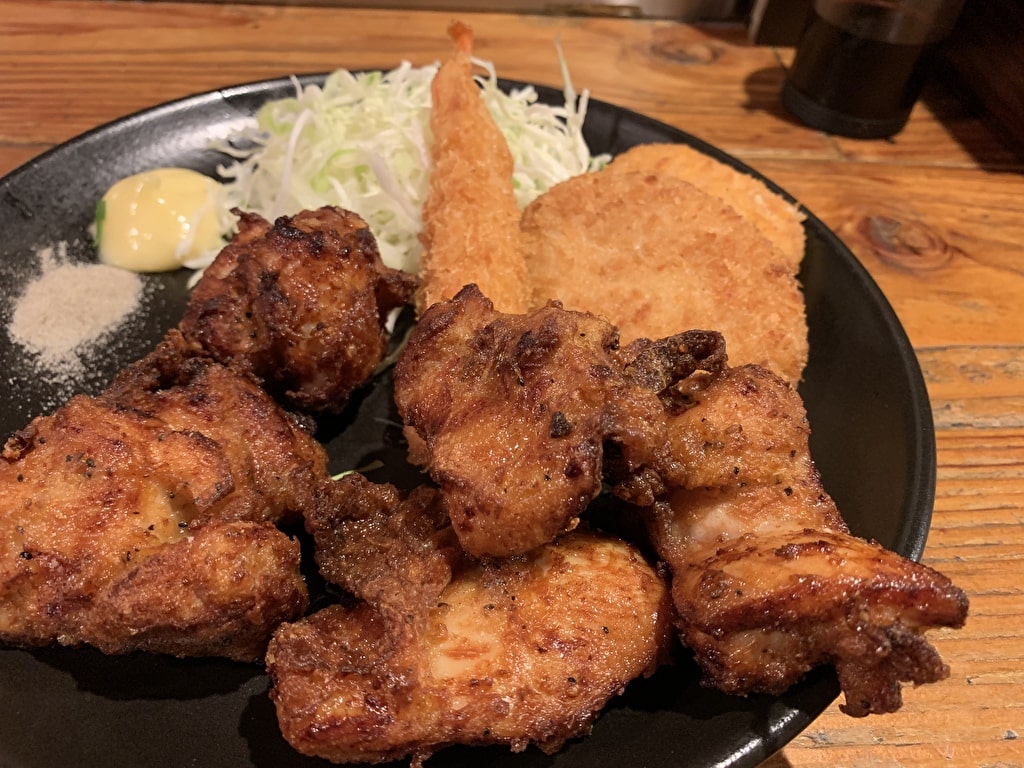夏の風物詩・かき氷。氷室から仕入れた大きな氷を削り機に挟んでシャリシャリと…今はそんな光景を目にすることも少なくなりました。
夏にかき氷を提供するお店はたくさんありますが、やはり削り方やシロップ次第で出来栄えが変わってしまうもの。食事のデザート的な位置付けのお店もあれば、中にはかき氷だけで行列を作ってしまう店も少ないながら確実に存在します。
今回ご紹介するお店は、京都市内でかき氷目当ての行列ができる老舗甘味処。猛暑に耐えて行列に並んだ後のかき氷…生ビール以上に格別な味になりそうじゃありませんか?
中村軒|麦代餅で夕方な京都・桂離宮前の老舗甘味処…抹茶と和菓子だけでなく、夏にはかき氷目当ての行列が
中村軒は創業明治16年の老舗甘味処。桂離宮に隣接し、場所柄皇室にもよく利用されるという和菓子の名店です。「麦代餅(むぎてもち)」という名の和菓子で有名で、おくどさん(かまど)に割木を燃やしてじっくり熱を伝え、昔ながらの製法でふっくら炊き上げた粒あん…この粒あんを中に包んだ麦代餅は、店内で抹茶と一緒にいただくこともできますし、有名デパートなどで購入することもできます。
今回中村軒を訪れたのは、7月の晴れた日曜日。店頭に和菓子販売のカウンターがあり、奥の座敷席までの間の空気が入店待ちの待機スペースになっているのですが、すでに和服を着たカップルや家族連れ客で飽和状態。さすがの人気ぶりです。

店頭に自動の整理券印刷機が置いてあり、来店したらまずここで順番待ちの登録をします。順番が来たら呼ばれますので、店内の待機スペースか店外お近くのところでお待ちください。この時は先に9組のお客さんが待っていましたが、結構回転は早く15分ほどの待ち時間で座敷奥の部屋に案内されました。
麦代餅で有名な中村軒…和菓子とお抹茶もいいですが、やっぱり夏はかき氷でしょ!
中村軒のイートスペースは、店頭から見える座敷席の奥にもテーブル席、カウンター席と続きます。おそらく40-50名くらいは座れるスペースがあると思いますが、そのほとんどのお客さんがかき氷を食べていたようです。
僕が案内されたのは、中庭を臨むカウンター席。目の前の大きなガラス越しに、和式の坪庭が拝める絶好の席。きちんと整備された草花や灯籠を眺めていると、それだけで心が癒される気がします。これでかき氷がますます美味くなりそうです…

中村軒の定番かき氷メニューとお値段はこちら…
- ミルク氷 790円
- ミルク金時 930円
- 宇治氷 790円
- 宇治金時 930円
- 宇治ミルク氷 890円
- 宇治ミルク金時 1030円
- ちょっと一口宇治金 590円
- 桂うりの氷 590円
- みぞれ 720円
- 大島氷(黒蜜) 720円
- あんみつ氷 890円
- こおり華(梅酒ゼリー入り) 790円
- ゆず氷 890円
季節限定のマンゴー氷:ねっとり濃厚なシロップとふわふわ氷のコラボを楽しみたい方はお早めに…
中村軒では、上の定番メニューの他に、よそでは食べられない季節限定かき氷も提供しています。今年の6月はいちごで始まり、今はマンゴー、今後はすだち、イチジクと続いていくようです。
やっぱりここは季節限定のマンゴー(税込820円)を注文。10分ほどして運ばれてきたかき氷はこちら…

ガラスの器からこんもり高く盛り上がった氷の山に、ねっとり濃厚なマンゴーシロップ、その頂に1片のマンゴー果肉がトッピング。
さて、どこから食べていこうか…と一瞬考えた結果、山の側面から削っていくことにして、山の右側にスプーンを入れます。スプーンは力を入れずとも中まですーっと入っていき、削られた氷のきめ細かさがうかがえます。
どのにスプーンを入れても粉雪のように細かいかき氷…ふわふわという表現すら当てはまる氷は、口の中でサーっと溶けていき、過度に口を冷やしたりせずに喉を通っていきます。
そんなサラサラふわふわのかき氷ですが、もう一つの驚きは、スプーンで山を削っていっても型くずれしないのです。柔らかな氷の食感と両立させるのは、さぞかし困難なことでしょう。それだけに、お祭りの縁日で食べるかき氷とはやはりレベルが違います。
画像を見て「氷が山盛りなので、シロップが足りないかも…」思ったあなた、ご安心ください。断面を見ると、中にもう一段シロップの層があります。これなら最後までマンゴーシロップを楽しめそうですよね。さらに、これでも足りない!という人のためにシロップの追加分を一緒にだしてくれるので、ねっとりマンゴーを堪能するにはこれで十分ではないでしょうか。

京都らしい坪庭を目の前にしながら、夏の風物詩・かき氷を存分にいただく…こんな日中の過ごし方も風情があっていいものですね。
白味噌雑煮:ただ上品なだけじゃない…味の広がりが半端ない中村軒の冬季限定メニュー
そんな中村軒ですが、冬は冬でまた特別なお楽しみがあります。そのお楽しみとは、冬季限定メニューの白味噌雑煮(お値段 950円)。京都で一番と言われる老舗・山利の白味噌を使った京風のお雑煮、一体どんな味がするのでしょうか…
というわけで、ある冬の日曜日に中村軒を再訪。茶店は朝の9:30から開くのですが、9時半を10分ほど過ぎてお店に入った時にはすでに数組の先客がお雑煮を楽しんでいました。
それでは早速、中村軒のお雑煮をご紹介しましょう…

大きな器一杯に注がれた真っ白な白味噌汁。この中に餅が入っているはずですが、表面から中の様子をうかがい知ることはできません。ちょっと中を掘り起こしてみると…

中身は純白の餅が2つと1切の里芋。飾らないシンプルなお雑煮ですが、それゆえにかえって高級感を感じさせてくれます。
まずはおつゆを一口…かすかにとろみのついたおつゆが舌をねっとりとコーティングし、そこから白味噌独特のほんのりした甘さが口全体に優しく行き渡ります。 喉を通り過ぎた後も胃袋からおつゆの熱が身体にじんわり伝わりって、芯からぽかぽか温まれます。
近江産の羽二重もち米を使って毎朝つくという丸餅は、均一につかれていて滑らかでとても柔らかいです。里芋もほっこりしていて、これだけでも心温まる一杯なのですが…

ここに削り節を投入すると、おつゆの風味が一気に変わります。いやいや、驚きです。もちろん鰹節も家庭用のものとはわけが違います。でも、たったこれだけで旨味爆発というか、二次元世界が三次元世界になったくらいの味の広がりが生まれるのです。これはどハマりです。家でも白味噌雑煮を作って試してみたくなりました。
ちなみに、この白味噌雑煮はお持ち帰り用も売られています。通販にも対応していますので、興味のある方はインターネットでお店のwebサイトをのぞいてみてください。
麦代餅:もちもちすぎる外の餅とスッキリした甘さのあんの組み合わせは、まさに和菓子の優等生
白味噌雑煮を完食後、残った胃袋のスペースを埋めるために、かの有名な中村軒の名物・麦代餅(お値段 300円)を追加でいただくことにしました…

想像していたよりかなり大きいです。端から端まで14〜15cmくらいあるでしょうか。「こんなに大きいのいらないよ」という時には、1個220円のミニサイズにすることもできます。

早速、竹のナイフで中を割ってみましたが…外の餅がもちもちすぎて、二つに割るのに一苦労。この状態になるのに、体感的には4〜5分かかっている感じです。こんなもちもちの和菓子が美味しくないわけがないのですが、ちょっと食べ方には困りますね。
お店の人は「切りにくければ手づかみで…」と言っていましたが、手にきな粉はつくし、お行儀良く見えないし…その意味でも普通サイズを食べるのは、女性にとっては少し抵抗があるかもしれません。
そして実食…外の餅のもちもち度は予想していたことですが、口の粘膜から伝わってくる餅の繊細さが何とも言えません。中のあんもスッキリした甘さで、まさに「和菓子の優等生」という感じです。一緒に頼んだお抹茶(おうす:お値段 460円)ともよく合います。京都に観光に来られたら、このために中村軒に立ち寄る価値ありです。

中村軒は2020年秋から半年間茶店の営業を休止…白味噌雑煮を食べたければ今年のうちに
中村軒は施設老朽化に伴い、2020年の秋から茶店の営業を休止することを公式に発表しています。改修工事が今年の10月から来年の4月までかかる見込みで、白味噌雑煮やおしるこなどの冬季限定メニューは来年は食べられないということです(お持ち帰り用はあるかもですが)。
このブログを見て中村軒のお雑煮を食べたくなったら、是非とも今年中に食べておくことをおすすめします。白味噌雑煮の販売は2月の末までです。
桂離宮への観光後の休憩に最適…中村軒へのアクセスは、最寄り駅の阪急京都線・桂駅東口からバスを利用し桂離宮前下車
それでは、店舗の詳細です。

P.S. 京都で美味しいお雑煮をお探しのあなた、ぜひこちらの記事にも立ち寄っていってください…
P.P.S. 純和風の茶店もいいですが、台湾産の高級オーガニックコーヒーや高山茶を飲めるカフェもおすすめです…


 京極かねよ|日本一の鰻を自称する京都市内の老舗うなぎ専門店
京極かねよ|日本一の鰻を自称する京都市内の老舗うなぎ専門店
コメントを残す